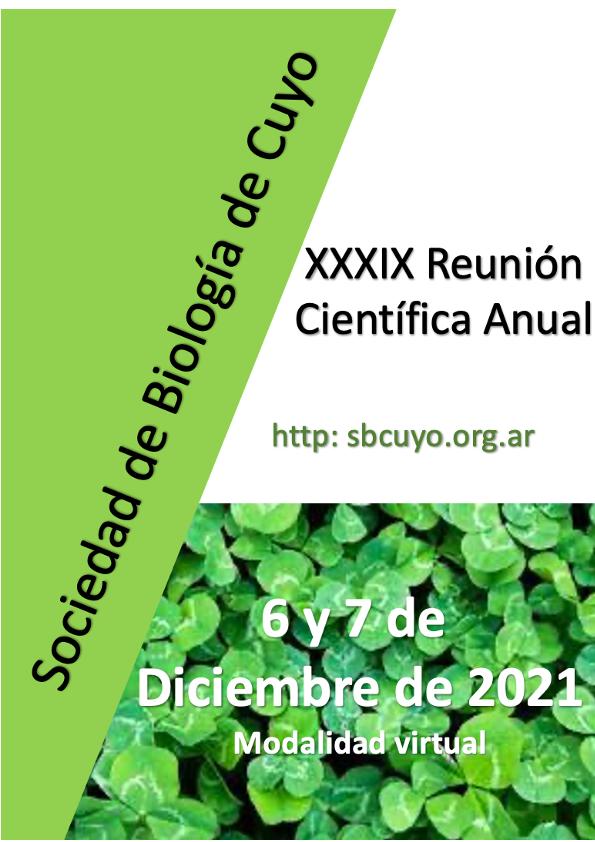Mostrar el registro sencillo del ítem
dc.contributor.author
Lucero, Mariela Cristina

dc.contributor.author
Escudero, María Esther

dc.contributor.author
Lucero Estrada, Cecilia Stella Marys

dc.contributor.other
Gomez, Nidia Noemí

dc.contributor.other
Castro, Claudia Magdalena

dc.date.available
2023-04-20T11:31:46Z
dc.date.issued
2021
dc.identifier.citation
Evaluation of physical-sanitary conditions in butcher shops of Justo Daract, San Luis; XXXIX Reunión Científica Anual de la Sociedad de Biología de Cuyo; Argentina; 2021; 57-57
dc.identifier.uri
http://hdl.handle.net/11336/194680
dc.description.abstract
Foodborne diseases are caused by ingestion of foodstuffs contaminated by microorganisms or chemicals. They are considered a growing public health problem worldwide. Foodstuff manufacturing equipment and the surrounding environment may serve as potential reservoirs of contamination. Foodborne pathogens are the cause of acute and chronic diseases. Food contamination by microorganisms may occur at any stage in the process from food production to consumption, and may be the result of environmental contamination. Moreover, cross contamination of food with pathogens in the retail environment is an important problem that contributes to an increased risk of foodborne illness. Some pathogenic bacteria such as Listeria monocytogenes, Salmonella spp. or Escherichia coli O157:H7 have the ability to attach onto stainless and other food-contact surface materials; as consequence, foodstuff manufacture equipment and the surrounding environment may serve as potential reservoirs of contamination. The aim of this work was to establish possible risk variables for contamination of meat products depending on the physical-sanitary conditions of facilities, equipment, and the personal hygiene of workers of butcher shops in the city of Justo Daract, San Luis, Argentina. This city located at the east region of San Luis province has 10 butcher shops for a population of 13,130 inhabitants. A risk quantification using a checklist was applied at every butcher shop in the city during September-December 2019. The checklist included five groups of variables (total value, 100): 1) situation and conditions of the building (10.0), 2) equipment and tools (15.0); 3), handlers (25.0), 4) raw materials and products for sale (20.0), and 5) production flow (30.0). Risk assessment on a 1–100 scale was quantified as high-risk (1–40), moderate-risk (41–70), or low risk (71–100). Risk quantification in all butcher shops resulted in two (20.0%) moderate-risk and eight (80.0%) low-risk shops. Minimum-maximal values obtained for each group of the five variables were as follows: situation and conditions of construction, 6.0-9.0; equipment and tools, 10.5-15.0; handlers, 18.7-25.0; raw materials and products for sale, 6.6-20.0; and production flow, 15.1-30.0. Due to the results obtained, some changes are recommended: i) to implement programs of good hygienic and manufacturing practices that allow a strict and constant sanitary control to ensure food safety; and ii) to train butcher shop personnel through a Guide or Protocol of Good Handling Practices to improve the microbiological quality of the product and the hygienic-sanitary conditions of sale establishments and thus, minimize the disease risk that might represent the consumption of meat products.
dc.format
application/pdf
dc.language.iso
eng
dc.publisher
Sociedad de Biología de Cuyo
dc.rights
info:eu-repo/semantics/openAccess
dc.rights.uri
https://creativecommons.org/licenses/by-nc-sa/2.5/ar/
dc.subject
CONDICIONES AMBIENTALES
dc.subject
CARNICERÍAS
dc.subject
JUSTO DARACT
dc.subject.classification
Biología Celular, Microbiología

dc.subject.classification
Ciencias Biológicas

dc.subject.classification
CIENCIAS NATURALES Y EXACTAS

dc.title
Evaluation of physical-sanitary conditions in butcher shops of Justo Daract, San Luis
dc.type
info:eu-repo/semantics/publishedVersion
dc.type
info:eu-repo/semantics/conferenceObject
dc.type
info:ar-repo/semantics/documento de conferencia
dc.date.updated
2022-11-09T17:26:28Z
dc.journal.pagination
57-57
dc.journal.pais
Argentina

dc.journal.ciudad
Mendoza
dc.description.fil
Fil: Lucero, Mariela Cristina. Universidad Nacional de Villa Mercedes. Escuela de Ingeniería; Argentina
dc.description.fil
Fil: Escudero, María Esther. Universidad Nacional de San Luis. Facultad de Química, Bioquímica y Farmacia. Área Microbiología; Argentina
dc.description.fil
Fil: Lucero Estrada, Cecilia Stella Marys. Universidad Nacional de San Luis. Facultad de Química, Bioquímica y Farmacia. Área Microbiología; Argentina. Consejo Nacional de Investigaciones Científicas y Técnicas. Centro Científico Tecnológico Conicet - San Luis. Instituto Multidisciplinario de Investigaciones Biológicas de San Luis. Universidad Nacional de San Luis. Facultad de Ciencias Físico Matemáticas y Naturales. Instituto Multidisciplinario de Investigaciones Biológicas de San Luis; Argentina
dc.relation.alternativeid
info:eu-repo/semantics/altIdentifier/url/http://fcm.uncuyo.edu.ar/expertos-nacionales-e-internacionales-presentan-nuevos-horizontes-del-conocimiento-en-ciencias-biologicas
dc.conicet.rol
Autor

dc.conicet.rol
Autor

dc.conicet.rol
Autor

dc.coverage
Nacional
dc.type.subtype
Reunión
dc.description.nombreEvento
XXXIX Reunión Científica Anual de la Sociedad de Biología de Cuyo
dc.date.evento
2021-12-06
dc.description.paisEvento
Argentina

dc.type.publicacion
Book
dc.description.institucionOrganizadora
Sociedades de Biología de Cuyo
dc.source.libro
Libro de Resúmenes: XXXIX Reunión Científica Anual de la Sociedad de Biología de Cuyo
dc.date.eventoHasta
2021-12-07
dc.type
Reunión
Archivos asociados
